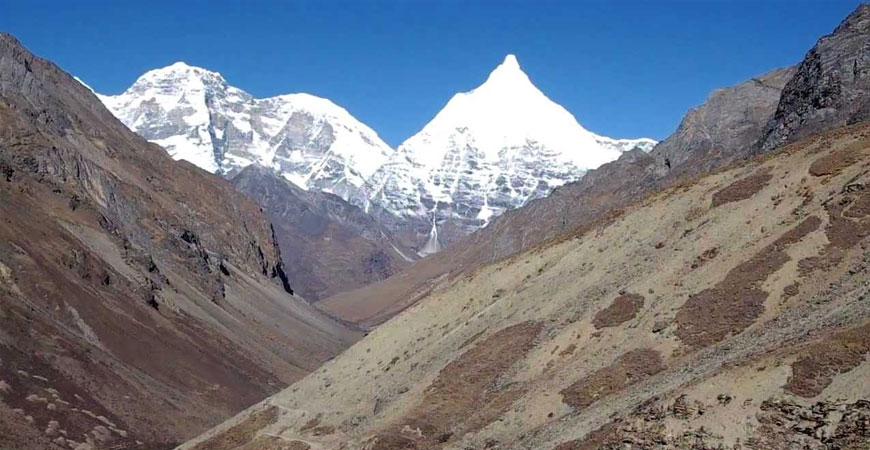Chomolhari Trek in Bhutan
$2500
Per Person
Overview
Chomolhari/Jomolhari is the second tallest mountain in Bhutan. This mountain is sacred to Buddhist's, thousands of trekkers are attracted every year by the beauty of this mountain and the things one could see during this trek. The scenic view of himalayas, agricultural valley, rhododendron forests and beautiful waterfalls are the rewarding one. Yaks and yak herder's winter home, different kinds of wild animals such as musk deer , blue sheep, langur monkeys seen on the way, wide yak pastures, different fortress are the other interesting factors of this trek. At some places we need to make our shelter inside stones which will be a new experience. We, Nepal Tibet Tours & Treks has beeen organizing Chomolhari treks since a long time, come and enjoy your holiday with us and make your holiday an extraordinary one.
Note: This Tour can be combine with Nepal, India or Tibet Tour!
Included/Exclude
- English speaking trekking/tour guide throughout the tour
- Accommodations in center located best Hotel, Guest House or Camp
- Private vehicle for all transfer per the itinerary
- Private driver
- All necessary Travel permit
- Entrance tickets for all the sights per the itinerary
- Petrol for the tour vehicle
- Airfares
- Airport taxes
- visa fees (US$ 20), airport departure tax (US$ 10)
- Personal Natural expense like Drinks, Laundry, IDD calls, etc
- Bank Telex wire transfer processing fee
- Tips for your guide and driver
- Tipping and all not mentioned above
- Travel Insurance
Trip Itinerary
Day 1: Arrive - Paro(2200m)
Upon arrival at Paro Airport, you will be received by our representative and transferred to hotel. Overnight in hotel.
Day 2: Paro [Sightseeing]
Drive to the winding road northward up the Pa Chu to Drugyel Dzong, the ruined fort that once defended this village from Tibetan invasion. Mount Chomolhari, the sacred summit, reaches skyward beyond the Dzong. This can be viewed on the clear day. On the way back visit a typical Bhutanese farmhouse. After lunch walk up the hill just above the Olathang hotel to stretch your legs for the onward trek. Or day excursion to view Taktsang Monastery can be arranged. Overnight in hotel.
Day 3: Paro -Shana(2800m)
Today morning you drive to Drugyel Dzong where the motor road ends and the trek begins, following the river gently uphill through a narrowing agricultural valley. Lots of homes, kids and dogs on the way can be witnessed. Camp will be made just beyond an army post. Alt. 2,800m distances 17Kms about 5/6hours.
Day 4: Shana-Thangthangkha(3570m)
Today you will continue uphill through the river valley. It narrows and closes in and the trail winds up and down along the drainage. Camp is in a meadow with stone shelter for trekkers.
Day 5: Thangthangkha-Jangothang(4500m)
As you reach the Pa Chu and pass a small army post, then the valley begins to winder again. Now views of high ridges and the snow-capped peaks are all around. You begin to see Yaks and Yak herder's winter homes. Lunch will be probably at one of these. Camp will be made beneath a ruined fortress at one of the base of Jhomolhari. Alt. 4,040m, distances 19Kms about 5/6hours.
Day 6: Jangothang-Lingshi(4150m)
After breakfast, you will be witnessing the cultural program of masked people and folk dances and after this event, you visit traditional hospital, National library, Memorial chorten, and at the late afternoon, you do some shopWide Yak pastures are on the way up and down the pass, possibly still some people in their Yak tents depending on the time of year you are there. Greasy views of Lingshi Dzong as you come down into the Lingshi basin if the weather is clear. Tserim Khang and its descending glaciers at the north end of the valley. Camp is in the stone shelter for trekkers. It has an inside fire pit and you can sleep on the wood floor or in tent. Alt. 4,150m, distances 19Kms, about 5/6hours.ping in various handicrafts shops in Thimphu and drive to Paro. Overnight in hotel.
Day 7: Lingshi [Halt]
Today you halt at Lingshi and make an excursion to Tshokha (Lahe) i.e. base camp of Jichu Drake can be done. During the excursion hundreds of blue sheep, musk deer can also be seen on the way. Alt.4,500m, distance 15Kms about, 3/4hours.
Day 8: Lingshi-Shodu(3963m)
The trail ascends up to the Yalila (4,820m) from the pass mount Chomolhari, Tserim Gang and Masagang can be seen on clear day. There is actually considerable down to trail. Camp is stone shelter built for trekkers. It has an inside fire pits. Alt. 3,963m, distances 22km, about 7/8hours walk.
Day 9: Shodu-Barshong
Follow the Thimphu-Chu through the forest of rhododendrons watching beautiful water falls, it narrow and close in and trail winds up and down along the drainage. Ascending up to the ruins of Barshong Dzong. Camp just below ruined fortress with stone shelter for trekkers. Alt. 3,785m distances, 13km about, 3/4hours walk.
Day 10: Barshong - Dolam Dencho(3430m)
Descending down to meet Thimphu-Chu following gradually through the forest of thicker rhododendrons, and ascending up to pastureland. Camp in a meadow. Alt. 3,628m distances 11km about 3/4hours walk.
Day 11: Dolam Dencho - Thimphu(2300m)
Continue uphill through the forest to the small pass. The trail winds up and down along the drainage. The wild animal like langur can be seen. At Dodina you will meet the transportation. Distance 14km. about 4/5hours walk. Drive to Thimphu, overnight in hotel.
Day 12: Departure
Early morning transfer to Paro Airport for your onward departure flight.
Note: This itinerary can be customized as per situation.


